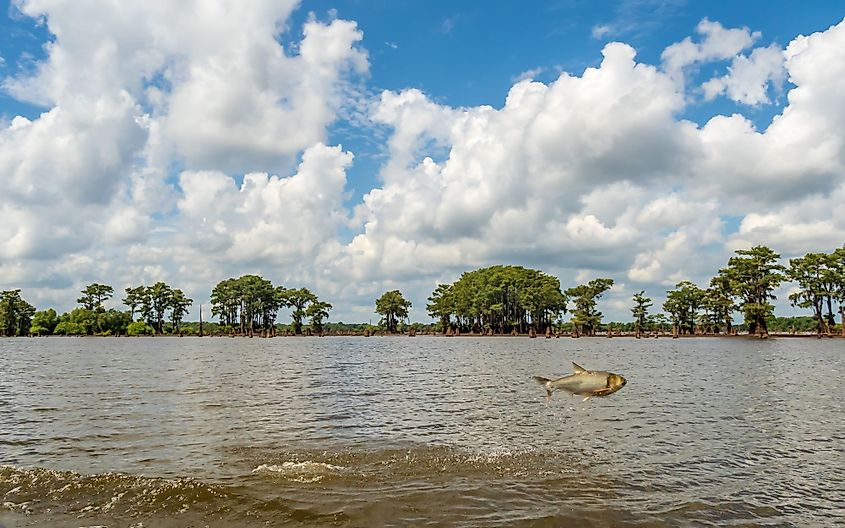
Atchafalaya Swamp
Atchafalaya Swamp is a large swamp located in the south-central portion of Louisiana and is considered to be the largest swamp in the United States. The swamp stretches from Simmesport in the north through regions of eight parishes to the Morgan City southern area, and it’s firmed by a combination of wetlands with a river delta where both the Atchafalaya River and the Gulf of Mexico intersect. What makes the Atchafalaya swamp special is its growing channel system, with its lake having about 30% wetlands and open water, and about 70% are covered by a forest ecosystem. The marshes there host the largest extending clusters of forested wetlands remaining in the lower Mississippi River valley due to the iconic cypress and tupelo wetlands that spread over an area of 260,000 acres, ranking as the largest remaining extended area of coastal cypress in America.
Geography Of The Atchafalaya Swamp

The Atchafalaya Swamp is the country's most extensive river basin, covering a total area of 2200 square miles, stretching over 20 miles wide and 150 miles long, and containing almost a million acres of the nation's most important hardwoods, swamps, marshes, and backwater lakes. The river basin has three parts: the upper part of the basin, which contains the largest adjoining bottomland hardwood forest in North America; the middle part, which includes the greatest cypress-tupelo swamplands on the continent; and the lower part, which features freshwater and brackish marsh. The most biologically dynamic parts of the Atchafalaya Basin contain almost 885,000 acres of forested wetlands and 517,000 acres of marshlands.
History Of The Atchafalaya Swamp

The Atchafalaya River Basin once covered more than 2 million acres of lacustrine and coastal delta systems, bringing up an unusual variety of wetland habitats. The Atchafalaya River Basin was controlled by Lac des Chetimachas, named initially after the Chitimacha Indian Tribe, who resided on a small, federally recognized reservation settled on the basin's edge. According to the Chitimacha, their tribe has always lived around the swamp for the last 80 centuries. The community started demolishing when a massive flood hit the Mississippi River in 1927, destroying the community after reaching seven feet above natural levees for weeks. As a result, the entire Atchafalaya Basin has been elected as an official floodway, and a series of artificial walls were built to adjust the flooding activities in the region. Another major flooding in 1937 drove many residents to move their homes to higher areas. However, all those measures were not sufficient to protect the residents from the yearly floodings, and the Bayou Chene's residents eventually had to relocate in 1952, moving to the suburbs of the basin in towns like New Iberia, St. Martinville, and Breaux Bridge. Today, little ruins of the swamp community are hidden under the misty waters of the Atchafalaya.
Ecology Of The Atchafalaya Swamp

The Atchafalaya Swamp is known for its habitat and biodiversity. This diversity contains large populations of wetland wildlife, supporting half of America’s migrating poultry by hosting around 270 bird species, including wood storks, osprey, spoonbills, as well as the highest nesting collection of bald eagles in this south-central part of the United States. Moreover, its canals are home to about 100 species of fish and 65 species of reptiles and amphibians, including thousands of American alligators, Louisiana black bears, white-tailed dears, bobcats, as well as coyotes, beavers, nutria, mink, otter, muskrats, armadillos, foxes, and opossums. Furthermore, the Atchafalaya swamp hosts a variety of non-native aquatic floras such as Salvinia minima, water lettuce, water-milfoil, Brazilian elodea, and alligator weed.
Points Of Interest In The Atchafalaya Swamp
Atchafalaya National Wildlife Refuge

Established in 1984, Atchafalaya National Wildlife Refuge conserves around 15,000 acres of the massive lower Mississippi bottomland hardwood forest and worn cypress-tupelo swamp habitats. Tourists visit the woods to enjoy the charming views of the blend of swamps, lakes, and bayous, or they can also hunt, fish, boat, bird watch, and paddle. Moreover, visitors can enjoy a variety of water activities there, like kayaking, along with hiking the trails around the Swamp to admire its picturesque environment and wildlife, in addition to some tours operating around the swamp area between Lafayette and Baton Rouge, wandering around the Swamp and the river through boats.
With each new season, the Swamp changes its look. Where winter brings in isolation and gloom as the morning fog covers the basin swamp, whereas spring marks the return of lush greeneries and vibrant colors that spread forward to embrace its new season, where the sunrise in the basin rouses its wild creatures. There’s a lot to see and admire, to fully understand and appreciate the magnificence of the Atchafalaya Swamp.











